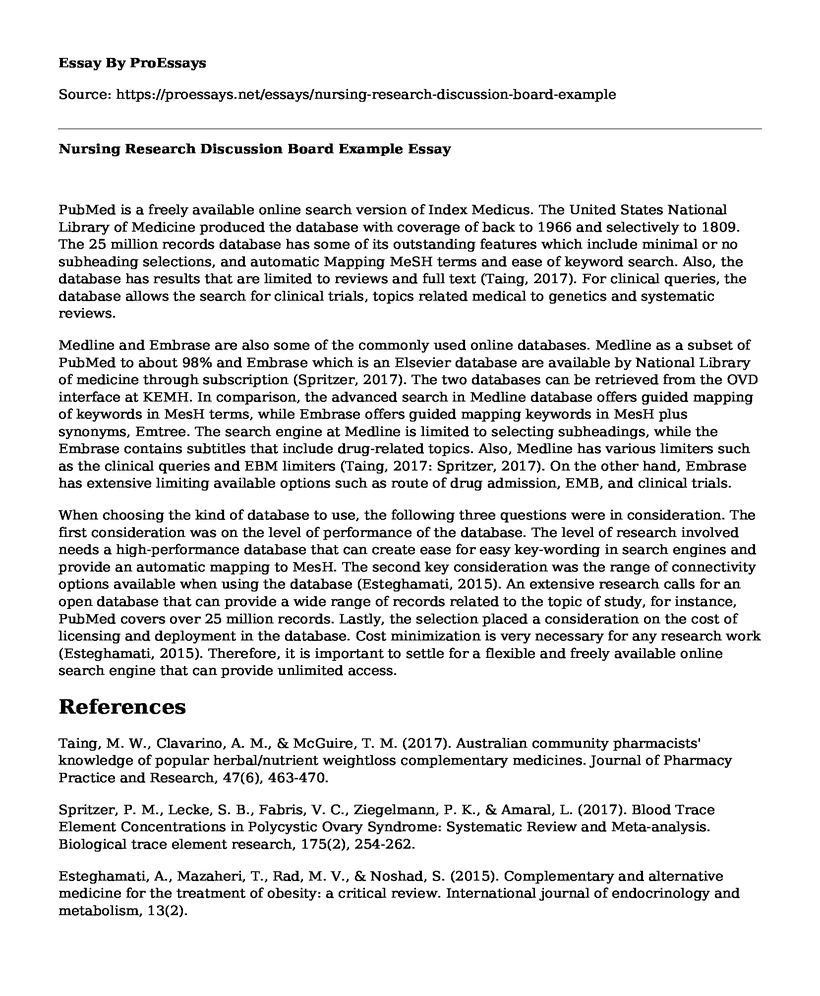PubMed is a freely available online search version of Index Medicus. The United States National Library of Medicine produced the database with coverage of back to 1966 and selectively to 1809. The 25 million records database has some of its outstanding features which include minimal or no subheading selections, and automatic Mapping MeSH terms and ease of keyword search. Also, the database has results that are limited to reviews and full text (Taing, 2017). For clinical queries, the database allows the search for clinical trials, topics related medical to genetics and systematic reviews.
Medline and Embrase are also some of the commonly used online databases. Medline as a subset of PubMed to about 98% and Embrase which is an Elsevier database are available by National Library of medicine through subscription (Spritzer, 2017). The two databases can be retrieved from the OVD interface at KEMH. In comparison, the advanced search in Medline database offers guided mapping of keywords in MesH terms, while Embrase offers guided mapping keywords in MesH plus synonyms, Emtree. The search engine at Medline is limited to selecting subheadings, while the Embrase contains subtitles that include drug-related topics. Also, Medline has various limiters such as the clinical queries and EBM limiters (Taing, 2017: Spritzer, 2017). On the other hand, Embrase has extensive limiting available options such as route of drug admission, EMB, and clinical trials.
When choosing the kind of database to use, the following three questions were in consideration. The first consideration was on the level of performance of the database. The level of research involved needs a high-performance database that can create ease for easy key-wording in search engines and provide an automatic mapping to MesH. The second key consideration was the range of connectivity options available when using the database (Esteghamati, 2015). An extensive research calls for an open database that can provide a wide range of records related to the topic of study, for instance, PubMed covers over 25 million records. Lastly, the selection placed a consideration on the cost of licensing and deployment in the database. Cost minimization is very necessary for any research work (Esteghamati, 2015). Therefore, it is important to settle for a flexible and freely available online search engine that can provide unlimited access.
References
Taing, M. W., Clavarino, A. M., & McGuire, T. M. (2017). Australian community pharmacists' knowledge of popular herbal/nutrient weightloss complementary medicines. Journal of Pharmacy Practice and Research, 47(6), 463-470.
Spritzer, P. M., Lecke, S. B., Fabris, V. C., Ziegelmann, P. K., & Amaral, L. (2017). Blood Trace Element Concentrations in Polycystic Ovary Syndrome: Systematic Review and Meta-analysis. Biological trace element research, 175(2), 254-262.
Esteghamati, A., Mazaheri, T., Rad, M. V., & Noshad, S. (2015). Complementary and alternative medicine for the treatment of obesity: a critical review. International journal of endocrinology and metabolism, 13(2).
Cite this page
Nursing Research Discussion Board Example. (2022, May 06). Retrieved from https://proessays.net/essays/nursing-research-discussion-board-example
If you are the original author of this essay and no longer wish to have it published on the ProEssays website, please click below to request its removal:
- Research Paper on the Health Care Issue: Nursing Shortage
- Social Media and HIPAA Paper Example
- Article Analysis Essay on Obesity Management Strategies
- Essay Example on Medicare: Federal Health Insurance Program for Seniors Above 65
- Essay Sample on Eating Disorders: Evolutionary Changes in Feeding Habits
- Public Health Promotion: Understanding Behaviors & Environments - Research Paper
- Essay Example on COVID-19: The Impact of Remote Working on Jobs and Businesses







